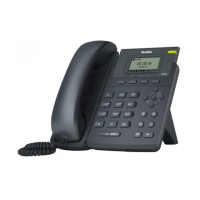Configuring Advanced Features
721
None
Phone User Interface:
None
Static DNS Cache
Failover redundancy can only be utilized when the configured domain name of the server is
resolved to multiple IP addresses. If the IP phone is not configured with a DNS server, or the
DNS query returns no result from a DNS server, you can statically configure a set of DNS
NAPTR/SRV/A records into the IP phone. The IP phone will attempt to resolve the domain name
of the SIP server with static DNS cache.
When the IP phone is configured with a DNS server, it will behave as follows to resolve domain
name of the server:
The IP phone performs a DNS query to resolve the domain name from the DNS server.
If the DNS query returns no results for the domain name, or the returned record cannot be
contacted, the values in the static DNS cache (if configured) are used when their
configured time intervals are not elapsed.
If the configured time interval is elapsed, the IP phone will attempt to perform a DNS query
again.
If the DNS query returns a result, the IP phone will use the returned record from the DNS
server and ignore the statically configured cache values.
When the IP phone is not configured with a DNS server, it will behave as follows:
The IP phone attempts to resolve the domain name within the static DNS cache.
The IP phone will always use the results returned from the static DNS cache.
Support for negative caching of DNS queries as described in RFC 2308 is also provided to allow
faster failover when prior DNS queries have returned no results from the DNS server.
IP phones can be configured to use static DNS cache preferentially. Static DNS cache is
configurable on a per-line basis.

